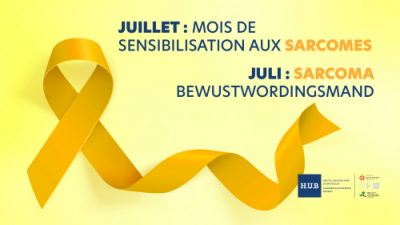Sarcoma in the spotlight throughout the month of July
News (30/06/2023)
Sarcoma in the spotlight throughout the month of July
The month of July is sarcoma awareness month. Sarcoma is a rare tumour of the bones and soft tissue that affects an average of 600 people a year in Belgium.
To increase the visibility of this often little known tumour, we invite you to wear a yellow ribbon throughout the month of July.
On 18 July, the parents' association CumCura will be present alongside our team to inform and answer questions from patients, those close to patients and members of staff. So please come along and meet them!
But what is sarcoma exactly?
This rare tumour affects an average of 600 people a year in Belgium. Sarcomas develop essentially in the bones and soft tissue (muscles, tendons, etc.) and affect both adults and children. Most new cases are sarcoma in the soft tissue.
The key symptom of a sarcoma is the appearance of a painless mass that increases in volume. The sooner the sarcoma is diagnosed the better the chances of recovery.
The cornerstone of sarcoma treatment is a radical surgical resection of the tumour. After this surgical resection it is often necessary to carry out bone reconstruction via a bone graft or a prosthesis. The reconstruction of soft tissue is by means of a muscle flap. Other means of treatment can be associated with the surgery, such as radiotherapy and, more rarely, chemotherapy.
Research in this field is extremely complex given the rarity and variety of these tumours. Nevertheless, certain progress is increasing the hope of a cure for patients, such as new targeted therapies or new digital technologies and 3D models.
Given the rarity of this tumour, it is important for patients to be treated at a centre of expertise such as the Bordet Institute and the HUDERF within the H.U.B. Thanks to a multidisciplinary team of surgeons, radiotherapists, radiologists, oncologist, nuclear medicine experts, anatomical pathologists, nurses and physiotherapists, patients can benefit from personalised treatment and follow up.
